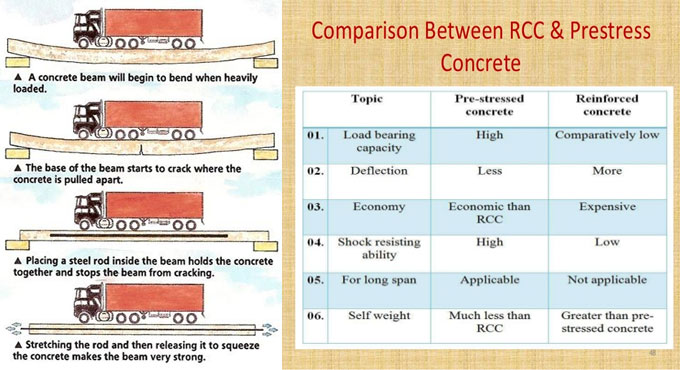
Basic Variations among RCC and Prestressed Concrete
In ordinary reinforced cement concrete, the concrete bears the compressive stresses whereas steel individually bears tensile stresses. The concrete underneath the neutral axis is not taken into consideration as it is feeble in tension.
While steel consumes the tensile stresses, the concrete in the tensile zone develops tiny cracks. The load bearing strength of such concrete sections is raised when steel and concrete both are stressed prior to enforce the exterior loads.
It is the basic idea of prestressed concrete. According to ACI committee prestresssed concrete belongs to the concrete in which internal stresses of correct magnitude are provided with the purpose of resisting the stresses caused by the external loadings to an optimal amount.
In R.C.C. members, resultant prestress contains compressive nature in order that it adjusts the tensile stresses formed because of exterior load. It creates the entire section effective (along with the concrete area in the tension zone) in withstanding the loads.
In reinforced concrete, prestress is normally started with tensioning the reinforcement. Therefore, compression is produced in the zones where exterior loads would generally induce tensile stresses. The prestressed concrete beam having rectangular section is exposed to a prestressing force P, at the centroidal axis. Because of this force, an identical compressive stress of ?P/A? is caused in concrete. Under the action of loads, the stress at any points will be ?My/I?.
The following materials are applied in Prestressed concrete:
Steel: Ordinary mild steel and deformed bars employed in RCC are not recommended for PSC (prestressed concrete) since their yield strength is quite low. In the prestressed concrete, loss of prestress (about 20 %) is caused by several factors.
When mild steel bars or HYSD bars are applied then very little prestress is left after the losses and remains unusable. So, high tensile strength steel is applied for prestressing. Besides, high strength, the steel applied in prestressing must contain a higher ultimate elongation. Several forms of steel are applied for prestressing as follows:
Tendons: Tendons stand for high strength tensile wires found in different diameters from 1.5 mm to 8 mm.
Wires strands or cables: A bundle of wires are knitted together to create a strand or cable. The overall diameter of a cable or strand differs from 7 to 17 mm. They are applied for post-tensioning systems.
Bars: High tensile steel bars with diameter 10 mm or more are also applied in prestressing.
Concrete: As high tensile steel is applied in prestressed concrete, the applicable concrete used should have good quality and high strength. So, the code suggests a minimum mix of M 40 for pre-tensioned system and M 30 for post tensioned system. These mixes contain high strength and a high value of modulus of elasticity of concrete which leads to less deflection.
The concrete applied in prestressed concrete should be well compacted. Due to the following facts, high strength concrete is utilized in prestressed concrete :
? Application of high strength concrete leads to smaller sections.
? High strength concrete provides high resistance in tension, shear, bond and bearing.
? Less loss of prestress happens with high strength concrete.
To get more details, go through the following link civilengineeringbible.com


